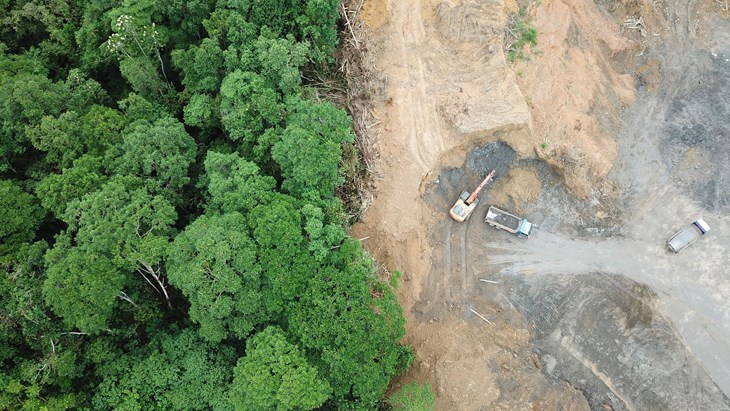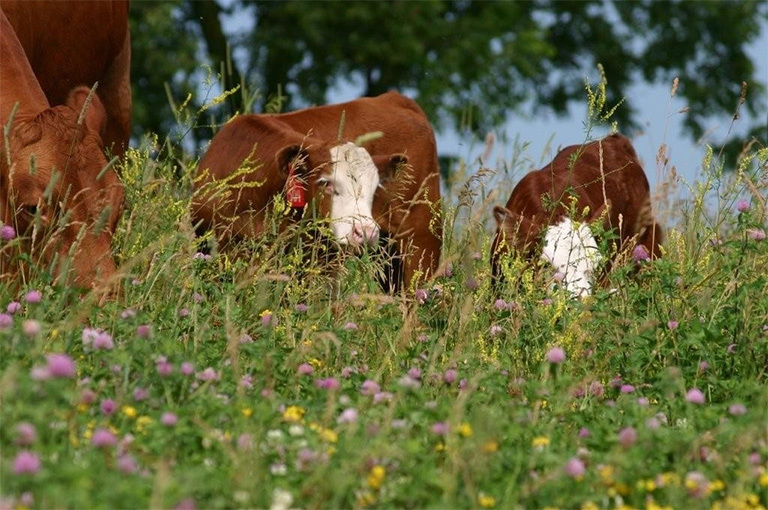Cruelty to animals on factory farms is inextricably linked to the demise of farmland birds, bees and butterflies as well as all sorts of wildlife not associated with farming at all, including penguins, polar bears, elephants, jaguars, orangutans and rhinos.
Factory farming sets off a cascade of cruelty and devastation. Farm animals are removed from the land into crowded sheds. Their feed is grown in vast crop prairies, usually doused in artificial fertilisers and chemical pesticides. These intensive monocultures effectively cause the removal of many trees, bushes, hedges, wildflowers, seeds, insects, birds, bees, bats and other wildlife, pretty much removing all life but the crop.
In the last 50 years, since the widespread adoption of factory farming, the total number of wild mammals, birds, reptiles, amphibians and fish worldwide has declined by more than two-thirds.
Bees are but one example of wildlife declines due to factory farming: essential for the pollination of a third of all our food and about three-quarters of all crops worldwide, since 1990, around a quarter of bee species have disappeared. Worldwide, some 40 per cent of insect species are in danger of extinction in coming decades. This collapse of biodiversity risks the future of our food.
As a recent UN report put it, “indispensable to food security, sustainable development and the supply of many vital ecosystem services” biodiversity is in decline, risking “severe production losses or livelihood disruption”. The economic value put on the pollinating services of bees and other insects has been estimated at between $235 billion and $577 billion.
Compassion showcased the biodiversity impact of factory farming at the seminal 2017 Extinction and Livestock Conference: Moving to a Flourishing Food System for Wildlife, Farm Animals and Us, with the World Wildlife Fund (WWF) and global experts, which led to our call for a UN Global Agreement on Food and Farming.
The weight of evidence is undeniable, not least captured in the book, Dead Zone: Where the Wild Things Were (Bloomsbury, 2017)
In February 2021, the Chatham House report Food System Impacts on Biodiversity Loss, published in partnership with Compassion and the United Nations Environment Programme (UNEP), identified that the intensification of agriculture - especially intensive animal farming - is the major driver of biodiversity loss and species extinction.
Introduction to the problem and scale
Of all mammals on Earth, livestock make up 60%, 36% are human and just 4% are wild animals. 70% of all birds are farmed poultry, 30% are wild2. These figures have changed dramatically over time.
Humanity, despite representing just 0.01% of all living things, has caused the loss of 83% of all wild mammals and half of plants, while livestock kept by humans have increased in large numbers3.
- 1 million wildlife species are faced with extinction as a consequence of human activity4.
- Studies show that population and species extinctions are proceeding rapidly, and a sixth mass extinction may already be underway5.
- Wildlife is disappearing 1,000 times faster than a ‘normal’ background rate6.
- There has been a 68% decline in the average size of populations of mammals, birds, fish, reptiles, and amphibians in just over 50 years as rainforests, savannah and pasture are destroyed7.
- Wild animal populations are also impacted by climate change – if global temperatures are limited to 2 degrees Celsius, about 25% of the planet’s plants and animals are likely to disappear8.
- Wild animals are integral to healthy eco-systems upon which humanity depends.
How is wildlife affected by factory farming?

Wildlife habitats such as forests and savannahs are being destroyed to grow soy and palm oil to feed industrially farmed animals and to provide pasture for cattle - this is driving many species towards extinction9.
This process of species depletion and habitat loss has accelerated in the years since the second world war following the adoption of large-scale industrial agriculture across much of the globe.
- Biodiversity loss in the Amazon’s forest and rivers poses a significant threat to a variety of species, some endemic, others endangered, and many of which are still unknown10.
- 70% of the forests cleared in South America are now under pasture11.
- Brazil is home to half the world’s jaguar population, but their numbers are shrinking as their habitat is destroyed to make way for soya plantations. 13 million hectares of South American land have been taken to grow soya, mainly to feed industrially farmed animals12.
- Half of the rainforests in Sumatra have been replaced with palm plantations producing food for people and animal feed. Habitat destruction has led to a 70% reduction of the Sumatran elephant population in the last 10 years13.
- The process of over-fishing to provide vast quantities of fish as animal feed prevents wild populations from recovering natural levels of biodiversity and removes natural food sources for native species.
- Since the 1960s the number of Dead Zones has almost doubled every decade. There are now more than 400 coastal dead zones in the world causing environmental harms and devastation to wildlife14.
Link to the relevant Sustainable Development Goal (SDG)
- SDG 14: Life below water. Conserve and sustainably use the oceans, seas and marine resources for sustainable development15
- SDG 15: Life on Land: Protect, restore and promote sustainable use of terrestrial ecosystems, sustainably manage forests, combat desertification, and halt and reverse land degradation and halt biodiversity loss16
- Eric Dinerstein, 2013. Kingdom of Rarities. Island Press.
- Damian Carrington Environment editor. The Guardian – based on a study taken from the Proceedings of the National Academy of Sciences.
- Damian Carrington Environment editor. The Guardian – based on a study taken from the Proceedings of the National Academy of Sciences.
- WWF (2020) Living Planet Report 2020 - Bending the curve of biodiversity loss. Almond, R.E.A., Grooten M. and Petersen, T. (Eds). WWF, Gland, Switzerland
- Geballos, G., Ehrlich, P.R., Dirzo, R. 2017. Biological annihilation via the ongoing sixth mass extinction signaled by vertebrate population losses and declines.
- De Vos, J.M., Joppa, L.N., Gittleman, J.L., Stephens, P.R., Pimm, S.L., 2014, Estimating the normal background rate of species extinction, Conservation Biology 29L452-462
- WWF (2020) Living Planet Report 2020 - Bending the curve of biodiversity loss. Almond, R.E.A., Grooten M. and Petersen, T. (Eds). WWF, Gland, Switzerland.
- Warren, R, Price, J, Van Der Wal, J, Cornelius, S, Sohl, H. The implications of the United Nations Paris Agreement on Climate Change for Globally Significant Biodiversity Areas. Climatic Change, 2018. Date of publication: March 2018
- Lymbery P, 2017. Dead Zones. Bloomsbury Publishing.
- Thomas Lovejoy. Taken from the interview ‘Why the Amazon’s Biodiversity is Critical for the Globe: An Interview with Thomas Lovejoy. World Bank.
- De Sy, V., Herold, M., Achard, F., Beuchle, R., Clever, J., G.P.W., Lindquist, E. & Verchot, L., (2015). Land Use patterns and related carbon losses following deforestation in South America. Environmental Research Letters 10: 124004. As referenced in Dominic Wormell’s chapter ‘Conservation and the Sacred Cow. Farming Food and Nature. Routledge. 2018.
- Compassion in World Farming Strategic Plan 2018-2022.
- Lymbery P, 2017. Dead Zones. Bloomsbury Publishing.
- Virginia Institute of Marine Science (VIMS), Trends, Low-oxygen ‘dead zones’ are increasing around the world.
- United Nations Department of Economic Social Affairs Sustainable Development
- United Nations Department of Economic Social Affairs Sustainable Development
